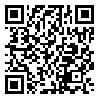BibTeX | RIS | EndNote | Medlars | ProCite | Reference Manager | RefWorks
Send citation to:
URL: http://salmandj.uswr.ac.ir/article-1-1090-en.html
2- Department of Occupational Health, School of Public Health, Kerman University of Medical Sciences, Kerman, Iran. , n_hasheminejad@kmu.ac.ir
3- Department of Occupational Health, School of Public Health, Bam University of Medical Sciences, Bam, Iran.
Objectives As people get older, their body systems become disrupted. As the elderly lose their abilities, they become more dependent on others. This study aimed to investigate the relationship between visual, hearing, and memory disabilities as well as hand grip strength and the systems usability available to the elderly living in nursing homes in Kerman, Iran.
Methods & Materials This cross-sectional study was conducted on 110 elderly participants (58 men and 52 women) living in nursing homes in Kerman. To investigate hearing, memory, and visual disabilities, the audiometry method, standard memory assessment questionnaire and E chart were utilized, respectively. Jamar Dynamometer was used to measure hand grip strengths. The systems usability (television, radio, and refrigerator) was measured via System Usability Scale (SUS) and analyzed by statistical tests with 0.05 level of significance.
Results The average age of the participants was 75.35 years. Hearing and visual disabilities were significantly different in left ears and eyes. There was no significant difference between men and women regarding their memory disability. However, hand grip strengths were significantly different in men and women (P=0.0001). The highest usability for both men and women groups was in using the refrigerator and the lowest in using television. The mentioned disabilities and hand grip strength of the elderly had a significant relationship with the ability to use television, refrigerator, and radio.
Conclusion With increasing age, the disabilities of the elderly get intensified and their ability to use systems decrease. Thus, it is necessary to prevent their loss of abilities in order to enhance their systems usability.
Received: 2016/07/06 | Accepted: 2016/10/18 | Published: 2017/01/01
| Rights and permissions | |
 |
This work is licensed under a Creative Commons Attribution-NonCommercial 4.0 International License. |






